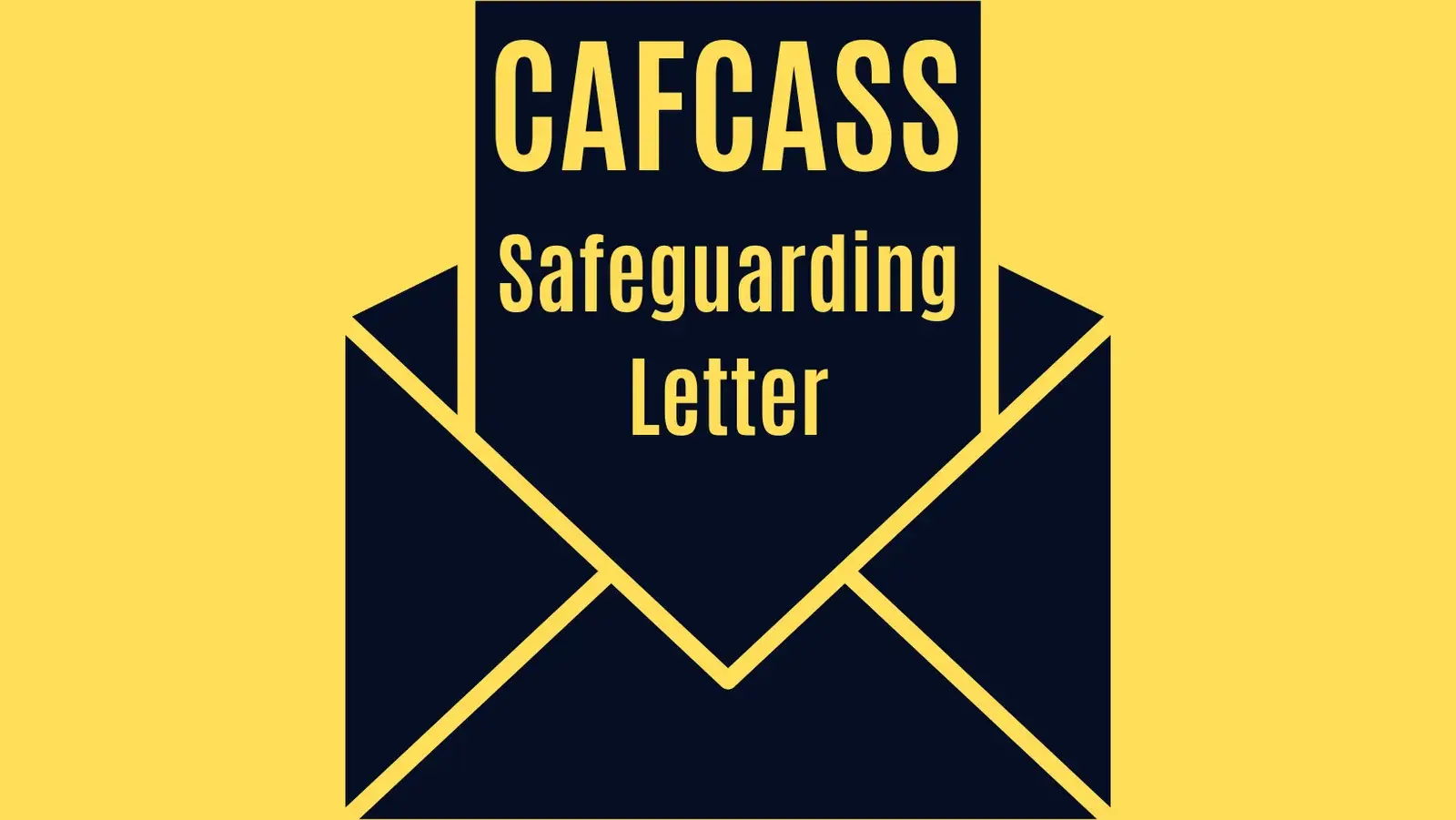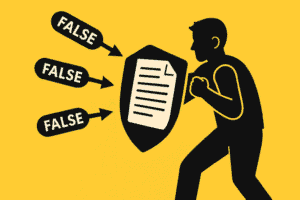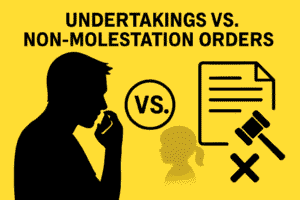Last Updated: Saturday, 6 September 2025
After the anxiety of the safeguarding call, an email lands in your inbox. It’s the CAFCASS Safeguarding Letter. This short, dense document is one of the most important you will receive in your entire case, as it’s the first piece of professional analysis the judge will read. For a father, trying to decipher its language and understand the implications of its recommendations can be a moment of intense confusion and fear. What does it actually mean? Is it good or bad for my case?
I have been subjected to significant emotional discomfort when fathers feel their fate has been sealed by this single letter. It is crucial to understand that this letter is not the final word; it is the starting point for the court process. As a consultant who has written hundreds of these letters for CAFCASS, I can help you decode it. This guide will explain what the letter is, how to interpret its recommendations, and how to prepare a strategic response for your first court hearing.
Key Takeaways
- The letter is a summary for the first hearing. Its purpose is to provide the judge with a brief snapshot of the safeguarding issues before your first court date (the FHDRA). It is not a full investigation.
- It summarises checks and both parents’ views. The letter will state the outcome of police and social services checks and will briefly outline the allegations and concerns raised by both you and your ex-partner.
- The recommendations are advice to the judge. The final section of the letter gives the court advice on how to manage the case. This could be a recommendation for a Section 7 report, a fact-finding hearing, or another course of action.
- You must respond to the letter. Your Position Statement for the first hearing is your opportunity to tell the judge what you think of the letter’s contents and recommendations, and to ask for what you want.
Worried about what your safeguarding letter could mean for your case? Message us on WhatsApp for fast, clear guidance.
Jump To
- What is a CAFCASS Safeguarding Letter?
- How to Read and Understand Your Safeguarding Letter
- A Deep Dive: The Different Types of CAFCASS Recommendations
- At a Glance: Positive vs. Negative Indicators in a Letter
- Common Mistakes Fathers Make After Receiving the Letter
- FAQs: The Safeguarding Letter
- Insider Insight from Lach
- Next Steps
What is a CAFCASS Safeguarding Letter?
The Safeguarding Letter serves as a pivotal document generated following a Safeguarding Call, initiated by the Children and Family Court Advisory and Support Service (CAFCASS). This letter is a comprehensive summary of the information gathered during the call, which includes details provided by both parties involved in the proceedings.
Just received your safeguarding letter and not sure what it means? WhatsApp us today and we’ll help you break it down.
How to Read and Understand Your Safeguarding Letter
The letter is typically only a few pages long, but it is packed with important information. When you receive it via the secure Egress system, your first step is to read it calmly and methodically. Don’t just skip to the end. The letter will be broken down into sections:
- Introduction: A brief summary of why CAFCASS is involved.
- Safeguarding Checks: The factual results of the checks with the Police National Computer (PNC) and local Children’s Services.
- The Parties’ Views: A very brief summary of the key issues and allegations raised by you and the mother during your respective safeguarding calls.
- Analysis: The officer’s initial professional take on the main safeguarding concerns.
- Recommendations: A numbered list of what CAFCASS advises the court to do next.
A strategic approach is to break the letter down and make notes as you go. This will form the basis of your Position Statement.
Need help turning your notes into a strong Position Statement? Tap WhatsApp now — we’ll guide you step by step.
Example: Your Notes Analysing the Safeguarding Letter
- Police Checks (Section 2): Letter says: “No trace on PNC for either party.” -> My Note: Good, this confirms there’s no police record to worry about. I will state in my Position Statement that I am pleased the checks confirm I pose no risk.
- Mother’s Views (Section 3): Letter says: “Mother alleges father is emotionally abusive.” -> My Note: Untrue. I denied this in my call. Must calmly and factually deny it again in my Position Statement.
- My Views (Section 3): Letter says: “Father denies allegations and raises concerns about mother’s new partner’s alcohol use.” -> My Note: This is correctly recorded. I will re-state these concerns.
- Recommendations (Section 5): Letter recommends: “A Section 7 Report to be prepared.” -> My Note: I agree with this. A full investigation is the best way to get to the truth. I will support this recommendation in court.
A Deep Dive: The Different Types of CAFCASS Recommendations
The final section of the Safeguarding Letter is a list of recommendations to the court. Understanding what these mean is crucial, as they will shape the entire future of your case.
Official Definition: The recommendations in a Safeguarding Letter constitute the professional advice given by CAFCASS to the court on how to safely manage the case and gather the necessary information to make a final decision in the child’s best interests. The judge at the FHDRA is not bound to follow them but gives them significant weight.
Breakdown of Components:
The safeguarding letter might only be a few pages, but every section carries weight. Breaking it down step by step helps you see what’s being said – and how you should respond strategically.
Recommendation: A Section 7 Report
What This Means For You: This is a very common recommendation. It means CAFCASS believes the issues are complex enough to need a full 12-16 week investigation into your family’s circumstances. If you feel the truth has not yet come out, this is often a positive step that you should support.
Recommendation: A Fact-Finding Hearing
What This Means For You: This is recommended when there are serious and conflicting allegations of domestic abuse. It means the court will need to have a separate hearing to decide who is telling the truth before it can move on to the child arrangements. This can cause significant delay and cost.
Recommendation: Interim Contact
What This Means For You: This is the most important recommendation for your relationship with your child right now. The officer may recommend that some form of contact (e.g., supervised at a contact centre) should begin immediately. If they do not, you must ask the judge to make an order for it anyway.
Recommendation: Specific Reports or Tests
What This Means For You: If there are concerns about substance misuse or mental health, CAFCASS may recommend that the court orders a drug/alcohol test or asks for a letter from a parent’s GP. A strategic approach is often to agree to these tests to prove you have nothing to hide.
A Real Life Scenario: A Safeguarding Letter is filed. In it, the mother has made serious allegations of physical abuse. The father has strongly denied them. The CAFCASS officer notes the conflicting allegations. The recommendation is not for a Section 7 report yet. Instead, the recommendation is for the court to list a fact-finding hearing to determine the truth of the allegations, and for no direct contact to take place in the meantime. The father’s immediate priority is now to challenge the “no contact” position and argue for supervised contact pending the hearing.
Common Pitfalls:
Many dads react to the safeguarding letter in ways that hurt their case rather than help it. Here are the common traps to watch out for and avoid.
- Ignoring a recommendation you disagree with: Why this is a mistake: If you disagree with a recommendation, you must explain why in your Position Statement. If you say nothing, the judge will assume you agree.
- Not pushing for interim contact: Why this is a mistake: The letter may not mention interim contact. Your Position Statement and what you say at the hearing is your chance to push for this. If you don’t ask, you often don’t get.
- Treating the recommendations as a final order: Why this is a mistake: They are just recommendations. The judge makes the final decision on what happens next.
At a Glance: Positive vs. Negative Indicators in a Letter
When you strip the jargon away, every safeguarding letter has signals the court will pick up on. This quick comparison shows the positives that strengthen your case – and the red flags that can undermine it.
| Feature | Positive Indicators ✅ | Negative Indicators (Red Flags) ❌ |
|---|---|---|
| Safeguarding Checks | ✅ Police and Children’s Services checks are clear for you (“no trace”). | ❌ You have recent, relevant police call-outs or Children’s Services history. |
| Your Position | ✅ The letter accurately records your child-focused position and willingness to co-parent. | ❌ The letter records that you were hostile, focused on adult issues, or refused to answer questions. |
| Analysis | ✅ The officer notes the conflict is between parents, rather than identifying you as a direct risk. | ❌ The officer explicitly states the allegations against you are “safeguarding concerns” requiring investigation. |
| Recommendations | ✅ A recommendation for a Section 7 report and/or interim contact arrangements. | ❌ A recommendation for no contact, a fact-finding hearing, or a referral to Children’s Services. |
Not sure if your letter shows positives or red flags? Message us on WhatsApp for a clear, expert review.
Common Mistakes Fathers Make After Receiving the Letter
What you do after receiving the letter can set the tone for your entire case. These are the mistakes that can weaken your credibility if you’re not careful.
- Sending an angry email to the CAFCASS officer. The officer has done their job. Complaining to them will achieve nothing and may be noted negatively. Your response now is to the court, not to CAFCASS.
- Not preparing a Position Statement. The letter is the agenda for the first hearing. You must file a written response. Failing to do so means the judge only has CAFCASS’s summary and your ex-partner’s views to go on.
- Focusing only on the negatives. If the letter contains unfair summaries, it’s easy to get angry. A strategic response acknowledges what is accurate before calmly correcting what is not. This makes you look reasonable and credible.
- Misunderstanding the next steps. The letter will shape the next hearing. You must understand what a Section 7 report or a fact-finding hearing involves so you can argue your case effectively.
FAQs: The Safeguarding Letter
Fathers seeing this letter for the first time often ask these questions.
What is a CAFCASS safeguarding letter?
It is a short report written by a CAFCASS officer for the judge before your first court hearing (FHDRA). It summarises the initial safeguarding checks (police and social services), the views of both parents, and makes recommendations for the next steps in the case.
Is the safeguarding letter the same as a Section 7 report?
No. The safeguarding letter is a brief, preliminary report for the first hearing only. A Section 7 report is a much more detailed, in-depth investigation that takes 12-16 weeks to complete and is only ordered if the judge agrees with a CAFCASS recommendation to do so.
What if the letter contains lies or inaccuracies?
You must address these in your formal written response to the court, which is your Position Statement. You should calmly and factually correct any errors for the record, pointing to any evidence you have if possible. Do not simply say “it’s all lies.”
How much weight does the judge give the letter?
A great deal. It is often the first piece of independent, professional advice the judge receives in the case. While the recommendations are not binding, judges follow them in the vast majority of cases unless a very compelling argument is made against them.
What does it mean if CAFCASS recommend a fact-finding hearing?
It means your ex-partner has made allegations of domestic abuse that you deny, and CAFCASS believes these allegations are so serious that the court must decide whether they are likely to be true or not before making long-term decisions about the children.
What does it mean if the letter refers my case to Children’s Services?
This is a serious development. It means the CAFCASS officer believes the safeguarding concerns may meet the threshold for “significant harm” under the Children Act 1989. The local authority will then be required to conduct its own investigation.
The letter doesn’t recommend any contact. What do I do?
You must ask for it. This is critical. In your Position Statement and at the hearing, you must ask the judge to make an “interim child arrangements order” for contact to begin, even if it has to be supervised at a contact centre initially, to maintain your relationship with your child.
Can I complain to CAFCASS about the safeguarding letter?
You can use the CAFCASS feedback procedure to complain about an officer’s conduct (e.g., if they were rude or unprofessional). However, this procedure cannot be used to challenge their professional judgment or the recommendations in the letter. Disagreements with the content must be addressed through the court process.
Will I get to speak to the CAFCASS officer again after the letter?
Not usually. That officer’s involvement (often called a Family Court Adviser) typically ends once the letter is filed with the court. If a Section 7 report is ordered, a different officer may be allocated to conduct that longer investigation.
How do I get a copy of the safeguarding letter?
CAFCASS will send the letter to you via a secure email system called Egress, usually a few days before your first hearing. You must register for a free Egress account to access it. It will also be sent to your ex-partner and the court.
Insider Insight from Lach
The Safeguarding Letter can feel like a verdict, but it is not. It is a tool for the judge to manage risk and structure the case at the very first hearing. The most common mistake I see is fathers reacting emotionally rather than strategically. The letter is not the end of the conversation; it is the start. Your Position Statement and your calm, reasonable arguments in court are your tools to shape what happens next. Use them wisely.
Meet Lach, Your Guide at Dads Consultancy
Understanding the safeguarding letter is your first major strategic challenge. With our fixed-fee support, we can help you decode your letter paragraph by paragraph and draft a powerful, court-ready response.
Next Steps
At Dads Consultancy, we provide the specialised, expert support to help you understand and respond to the CAFCASS safeguarding letter. Our founder is a former CAFCASS officer who has written these letters and knows exactly how to interpret their language and challenge their recommendations when necessary. We can help you with:
- Drafting Powerful Position Statements: We provide expert guidance to write a compelling response to the safeguarding letter, ready for your first court hearing.
- Handling the CAFCASS Call: We provide intensive preparation for the call that leads to the letter, helping you make the best first impression.
- Navigating Section 7 Reports: If a report is recommended, we can help you prepare for that next, more intensive stage of investigation.
- McKenzie Friend Court Support: We can attend the first hearing with you to help you argue your case in response to the letter.
The safeguarding letter sets the agenda for your entire case. Your response is your chance to influence that agenda.
👉 WhatsApp us today for a strategic consultation and let’s build a clear plan to respond effectively and protect your relationship with your child.
🧠 Insider Insight: Lach, our founder, is a qualified social worker who used to write Section 7 reports for CAFCASS — the very reports that influence court outcomes. Now he helps dads respond to them. Learn more about Lach’s background.
👉 Learn more about how we can support you or book a free consultation today




